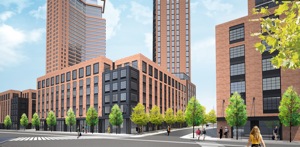Moses Gates has finished his walk around NYC – so, what’s next?
Greenpoint Landing Lands Tonight

Greenpoint Landing (via Crain’s)
Architect: Handel Architects
Greenpoint Landing – the 22-acre development at the north end of the Greenpoint waterfront – is scheduled to make its public debut at a Community Board 1 meeting this evening*. From what I’ve heard to date, the project itself is largely as of right – the number of units, tower heights, tower massing, etc. are all what was approved in the 2005 waterfront rezoning (as Matt Chaban notes, the development has gone from glassy to a more “contextual” brick with punched window openings).
What is new is that the developer will be constructing the affordable housing that the city had committed to as part of the 2005 rezoning (Greenpoint Landing is building 20% inclusionary on their property, and building additional units on a city-owned site that is being wrapped into the project – the number of affordable units isn’t actually increasing from what was promised). The other new thing is the inclusion of a school as part of the development – this latter bit might be the only thing that requires an actual zoning modification.
There is another item on tonight’s agenda that will require a zoning modification – the new development up the street at 77 Commercial Street. That project is acquiring the air rights from the MTA parcel at 65 Commercial Street. The air rights purchase will allow the city to construct the park it committed to build at 65 Commercial, but also certainly taller and bulkier development on the adjacent 77 Commercial site.
The Greenpoint waterfront has been aslumber ever since the 2005 rezoning was approved (eight years ago this week). Greenpoint missed the last real estate boom, but seems destined to get caught up in this one, and when that happens, it will make the Northside and even Long Island City look quaint by comparison.
*Pardon the Facebook link – CB1’s website is too useless to link to.↩

